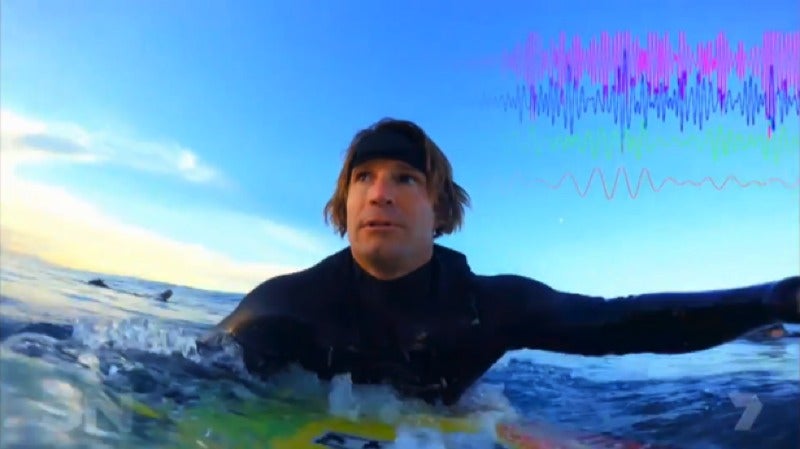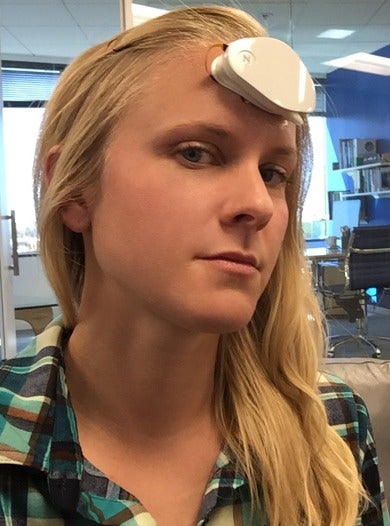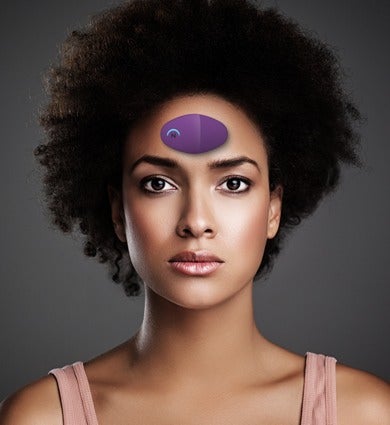The Best Little Brain Reader Your Money Can't Buy (Yet)
Source: Jennifer Ouellette
 Surf therapy: This is Australian reporter Denham Hitchcock’s brain on surfing. Credit: Neuroverse, Inc.
Surf therapy: This is Australian reporter Denham Hitchcock’s brain on surfing. Credit: Neuroverse, Inc.
Let’s be honest: it would be really cool to have a wearable personal brain-computer interface (BCI) that would monitor your brain waves while you do all your favorite activities. Not to mention being able to operate smart phone apps using your thoughts alone. That day is closer than you think.
Meet the BrainStation—your brain interface for everyday life. The creation of a company called Neuroverse, it’s basically a FitBit for your brain.
The standard BCIs available are, frankly, a bit ugly and unwieldy. They usually work by attaching electrodes directly onto the brain, or by wearing an EEG cap. That’s fine in a research or clinical setting. But what you want in a consumer device is something sleek, small, and elegant that attaches to your forehead like the proverbial third eye and operates wirelessly via Bluetooth. And it should come in a variety of colors, so you can be truly fashion forward. The BrainStation is just the ticket.

Photographer Rachael Porter models the BrainStation device.
Based in La Jolla, California, Neuroverse was founded in 2012 by Salk Institute neuroscientist Ricardo Gil-da-Costa (now Neuroverse CEO) and the University of California, San Diego’s Todd Coleman. The intent was to develop a broader, fully integrated brain interface platform flexible enough for a range of uses, from clinical to consumer.
The BrainStation is the actual EEG device, incorporating a flexible electronic substrate as a sensor. That particular piece of technology is based on Coleman’s work on flexible electronic temporary tattoos that can attach directly to the forehead to monitor brain activity.
The BrainStation connects wirelessly to a smartphone or tablet app. There are currently two versions of the app: BrainVitals (for mental health monitoring) and BrainQuantum (for general users), each offering tests, games, brain tracking, and brain control capabilities, as well as built-in social networking features. And the platform is flexible enough to enable other companies to design their own BrainStation-compatible apps in the future.
Users will need an internet connection for the initial download, but once they’ve signed up for the service (for a small monthly fee) and created a profile, they can use the system on the go, resyncing with Neuroverse’s central computer whenever the device is connected to the internet.
And I do mean on the go: check out this video of Australian reporter Denham Hitchcock taking the BrainStation (along with a GoPro camera) on its first surfing safari. At the top of the screen, you can see the EEG reading in real time, while at right you can see his brain wave patterns shift from mostly gamma and beta waves (indicative of focus, stress, and anxiety) to alpha and theta waves (associated with calm relaxation):
The device is water-resistant, according to Gil-da-Costa, but it isn’t waterproof. So you can use it surfing, but if you wipe out and end up fully submerged in the ocean, you’ll ruin your BrainStation.
Here’s an example of brain activity while playing Deus Ex. The gamma and beta waves dominate when the player is in the midst of a shootout, switching to alpha and theta waves when the action pauses for a bit of exposition:
All this sounds incredible, but does the device actually work? I visited the Neuroverse headquarters to find out. Gil-da-Costa swabbed my forehead to remove any impurities (like makeup) that could mess with the interface. Then he attached the device to my forehead with an adhesive, and opened the BrainQuantum app on one of the company iPhones.
My first mission: take a picture with the iPhone using two blinks of an eye. It worked like a charm, with one caveat: this is not a great method for selfies, since there’s a high chance of the camera catching you mid-blink.
Then it was onto the training games. There’s a classic memory matching game, and another that assesses attention and focus. The system analyzes your cognitive performance (and in some cases motor control, using the iPhone’s built-in accelerometer). You can share your scores via Facebook and Twitter, should you feel so inclined.
My favorite game involves target practice against an army of virtual ants. Most are black ants, but whenever a red ant looms into view, the aim is to position the target in its path by rocking your iPhone left or right, then blinking twice to “shoot” the ant. If you succeed, it explodes into bloody pieces.
Thanks to a special adaptive algorithm, the better your score, the harder the game becomes: the ants move faster and the target area gets smaller. When you miss a shot, the game will slow back down. Hit a black ant by mistake, and you “die.” Game over.
The blinking can be tricky at first. Much like taking a photo, you want to blink at just the right pace: not too fast, not too slow—and not too hard. Gil-da-Costa also advised us to time the first blink just as a red ant reaches the outer edge of the target area, so that the second blink occurs when the ant is dead center.
The hardest cognitive task (for me, anyway) involved trying to get a virtual rocket to rise to the top of the screen and stay there for three full minutes, just by focusing my mind:
The temptation is to think really hard about the rocket moving up—“Up! Go! Fly! Be free!”—but this is an exercise in futility. It’s a bit like that scene in The Matrix when Neo tries (and fails) to bend a spoon with his mind. If you just think about moving the rocket, it doesn’t work. You have to find some other way to fully engage your brain. I managed it by holding my breath and tensing all the muscles in my body like I was trying to pass a kidney stone, but (a) you can’t really hold your breath for three minutes, and (b) you look red-faced and constipated.
Brain training games are a controversial subject these days in light of the recent troubles faced by Lumosity, a leading supplier of memory and attention games that the company claimed could reduce the effects of dementia and boost memory and brain function. In January, Lumosity was hit with a $2 million fine by the Federal Trade Commission for false advertising. The public might have been surprised by the decision, but neuroscientists—Gil-da-Costa included—were not.
If the Lumosity games are bullshit, what makes those being developed by Neuroverse any different? It’s not the underlying concept that’s questionable here: there are many published papers on neuroplasticity demonstrating that such tests can improve cognitive performance over time. The devil is in the details. Most games currently on the market only track behavioral performance. The Neuroverse system actually records and evaluates your neural responses in real time.
“You can have two pills that look exactly the same. It is the active ingredient in each that will determine a successful treatment versus a useless sugar pill.”
“You can have two pills that look exactly the same,” Gil-da-Costa told Gizmodo. “It is the active ingredient in each that will determine a successful treatment versus a useless sugar pill. In cognitive training games, the necessary active ingredients are the specific details of the game design and the underlying adaptive algorithm.” When the game adjusts the play level according to how well you’re performing—speeding up the ants when you’re doing well, for instance, and slowing them down when you start to struggle—it can lead to real, measurable changes in cognitive function.
Case in point: neuroplasticity expert Adam Gazzaley (University of California, San Franciso) designed a game called NeuroRacer. He used it to demonstrate improved cognitive function in elderly subjects, and then adapted the clinical version into a consumer game for his spin-off company, Akili Labs. It’s currently undergoing FDA trials to verify its effectiveness in specific clinical populations. “That’s the right way to do it,” said Gil-da-Costa. “Each game would need to be very carefully designed and tested to verify that it is in fact eliciting those changes.”

Neuroverse
Lumosity skipped that step, but it’s what Neuroverse is doing now, which is why you can’t buy a BrainStation just yet.
The prototype system is currently being used in a number of clinical studies. For instance, Neuroverse is partnering with the Laureate Brain Research Institute to study the effects of float therapy on people suffering from PTSD or general anxiety disorder. UCSD psychiatrist Gregory Light is using BrainStation technology to monitor brain activity in patients with schizophrenia, while another UCSD researcher, Irene Litvan, is using it to learn more about the effects of Parkinson’s disease on the brain.
It’s not intended to replace conventional EEGs. An EEG cap isn’t necessarily more accurate than the BrainStation, according to Gil-da-Costa, but it will yield more extensive information about brain activity. BrainStation is designed to be cheaper, more mobile, and simple enough that even a novice can use it.
“Imagine how much we can learn about the brain by finally being able to assess the neural patterns associated with all sorts of mental processes in large groups of people, instead of a very small group in a sterile research environment,” said Gil-da-Costa.
The second-generation prototype I tried is great for clinical studies. But it’s still a wee bit bulky for everyday casual wear, and its usability isn’t quite where Gil-da-Costa wants it to be. The current version requires users to attach the flexible substrate to the device via a USB style port before sticking it on the forehead. So far, study subjects have managed just fine, but it would be nice to eliminate that extra step. Generation 3 will be half the size, and users will have the option of using the flexible electronic substrate or snapping in rigid sensors. The device will come with a compact case that charges the BrainStation wirelessly, with no need to even plug it in
There’s no official launch date yet for the consumer device, but when these little beauties finally hit the market, this is how we’ll all be playing League of Legends from now on.
| }
|